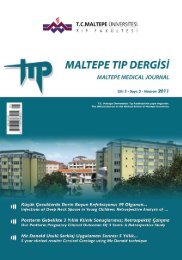Olgu sunumu - Maltepe Üniversitesi
Olgu sunumu - Maltepe Üniversitesi
Olgu sunumu - Maltepe Üniversitesi
Create successful ePaper yourself
Turn your PDF publications into a flip-book with our unique Google optimized e-Paper software.
32<br />
Sezgin ve Arkadafllar›<br />
<strong>Maltepe</strong> T›p Dergisi/ <strong>Maltepe</strong> Medical Journal<br />
serious side effects of these commonly used medications,<br />
which may cause serious organ injuries.<br />
We report a case of gemifloxacine related maculopapular<br />
rash accompanied by high fever and elevated<br />
liver enzymes to draw attention to this important clinical<br />
possibility.<br />
CASE PRESENTATION<br />
A 33-year-old man presented to the emergency<br />
department with facial and corporal rash and fever for two<br />
days. Ten days earlier he had taken prophylactic<br />
gemifloxacine tablets 320 for 7 days, in the course of<br />
preparation for surgery for nasal polyp. Skin rashes and<br />
fever occurred right after the cessation of the medication<br />
and he was seen by a physician who prescribed<br />
antihistaminic tablets which were not helpful in controlling<br />
either the fever or the rashes two days before his arrival to<br />
our hospital. He complained that his rashes increased in<br />
these two days and his fever was 38,3 °C in the emergency<br />
room. He was admitted to the hospital. His past medical<br />
history was non-contributory. Physical examination<br />
revealed normal findings except for high fever (38,3 °C),<br />
high heart rate (124/min) and conjunctival redness.<br />
Laboratory findings were also normal except for elevation<br />
of alanin aminotranspeptidase (ALT 96 IU/L, range:15-65).<br />
Cultures (urine, throat, blood) and viral markers for<br />
hepatotropic viruses were negative as were CMV IgM,<br />
Coxackie A and B IgM, and Rubeola IgM. The patient was<br />
put on IV fluids and antihistaminics and palliative measures<br />
for his fever (e.g. lukewarm bath). Next day his fever<br />
started lowering and his rashes were coalesceing along<br />
with resolution of conjuctival redness and photosensitivity.<br />
On the third day his symptoms were normal and he was<br />
discharged pending outpatient follow up. His laboratory<br />
tests returned to normal the next week after his discharge<br />
from the hospital with no fever or rashes.<br />
DISCUSSION<br />
A case for gemifloxacin-related rash, photosensitivity<br />
and liver enzyme elevation was consistent with this<br />
patient’s presentation and with treatment initiation. The<br />
search for other reasons in this patient revealed no other<br />
probable cause and the patient did not have any symptom<br />
progression after the cessation of the medication.<br />
Because of its easy use single dose administration and<br />
high bioavailability (>70%) gemifloxacine has found a<br />
wide area of usage among medical community dealing<br />
with infectious diseases (2); however increasing usage<br />
brought increased side effects such as gastrointestinal<br />
intolerance, hypersensitivity reactions, central nervous<br />
system reactions etc. (3).<br />
Any kind of antibiotics can lead to medication-related<br />
fever and fluoroquinolone related fever cases have been<br />
reported (4). Fever in our patient had started right after<br />
medication usage and no other causative agent have been<br />
revealed with diagnostic work up and gemifloxacine<br />
seemed like the only probable cause. Accompanying<br />
maculopapular rash is a known adverse effect of<br />
gemifloxacine (5). Ball et al has reported such rash with<br />
gemifloxacine without severe eruptions (5). Fever and rash<br />
resolved completely without any definitive treatment in a<br />
few days. Photosensitivity was a mild symptom and lasted<br />
shorter than fever and rash and we believe that these<br />
symptoms are interrelated.<br />
Pharmacokinetic studies has shown that gemifloxacine<br />
is a well tolerated medication and that elevations ALT levels<br />
were reported with use of 600 mg gemifloxacine for 6<br />
days (5). This patient used standard dose of the medication<br />
(320 mg) for 7 days and elevated ALT level has returned to<br />
normal in a week without any other therapeutic<br />
intervention which makes us believe that it is related with<br />
the medication.<br />
CONCLUSION<br />
This case highlights the need for clinicians to be<br />
cautious when using antibiotics. Continued care and<br />
caution is recommended as gemifloxacin and other<br />
fluoroquinolone usage is increasing for various infectious<br />
diseases, since these medications may increase likelihood<br />
of adverse effects, which are infrequently reported.<br />
REFERENCES<br />
1. Andriole VT: The quinolones: past, present and<br />
future. Clin Infect Dis 2005;41:119-129.<br />
2. Von Bambeke FV, Michot JM, von Eldere JV, Tulkens<br />
PM: Quinolones in 2005:an update. Clin Microbiol<br />
Infect 2005; 11: 256-280.<br />
3. Stahlmann R, Lode H: Safety considerations of<br />
fluoroquinolones in the elderly: an uptake. Drug<br />
Aging. 2010; 27: 193-209.<br />
4. Smith CR: The adverse effect of fluoroquinolones. J<br />
Antimicrob Chemother. 1987;19: 709-712.<br />
5. Ball P, Mandell L, Patou G (eds): A new respiratory<br />
fluoroquinolone, oral gemifloxacin: a safety profile in<br />
context, Int J Antimicrob Agents 2004; 23: 421-429.



